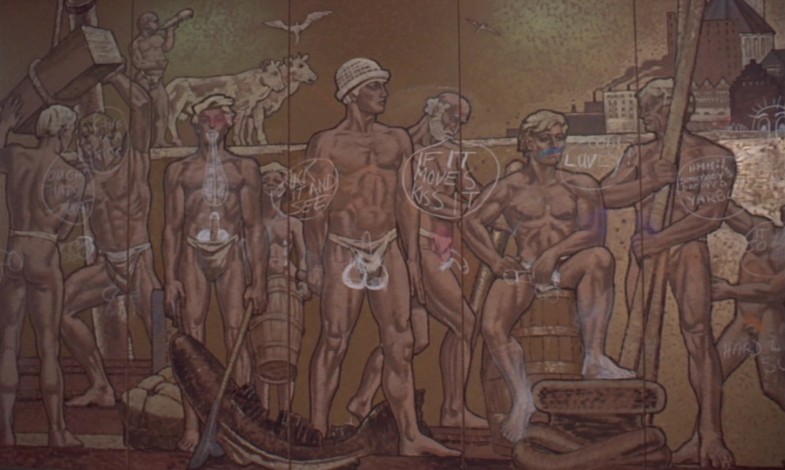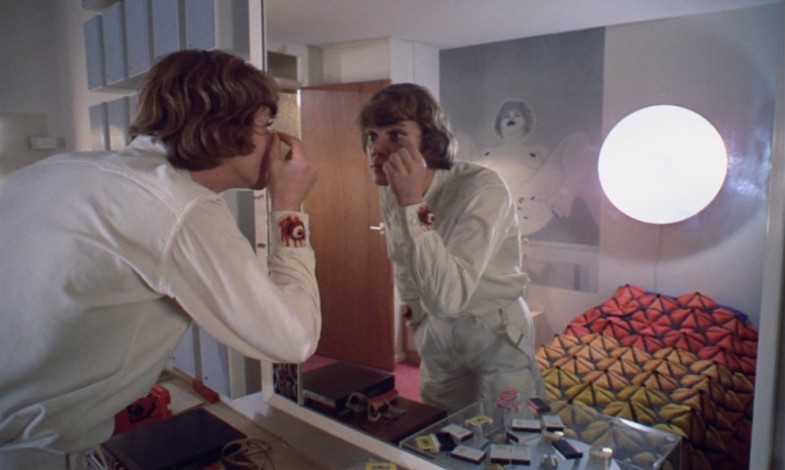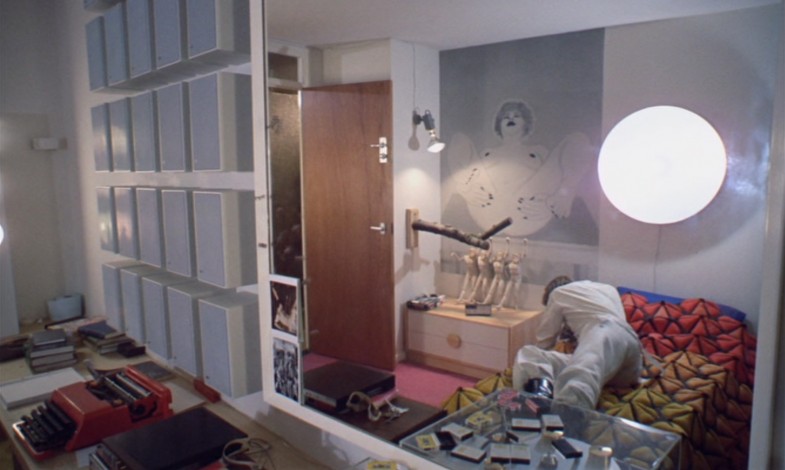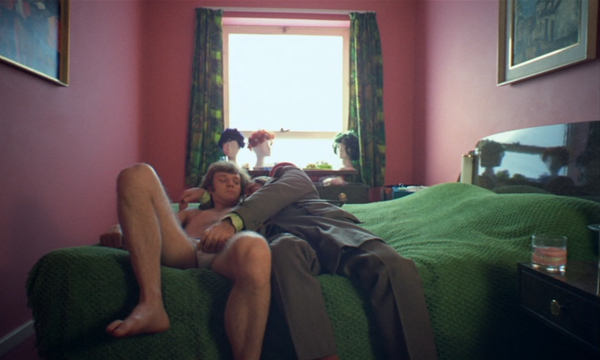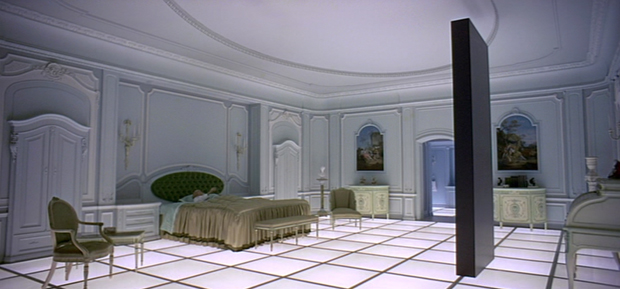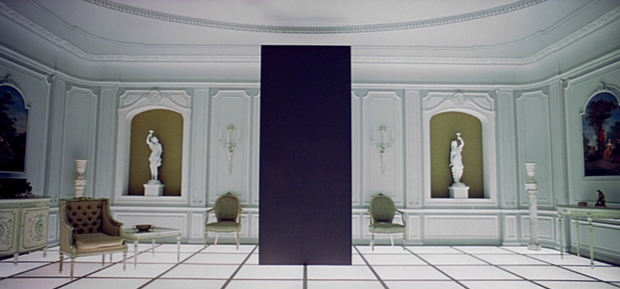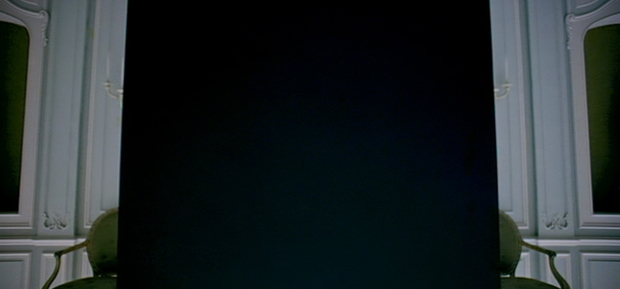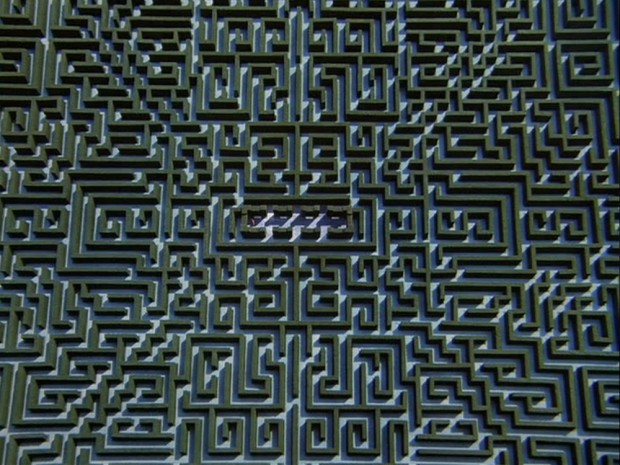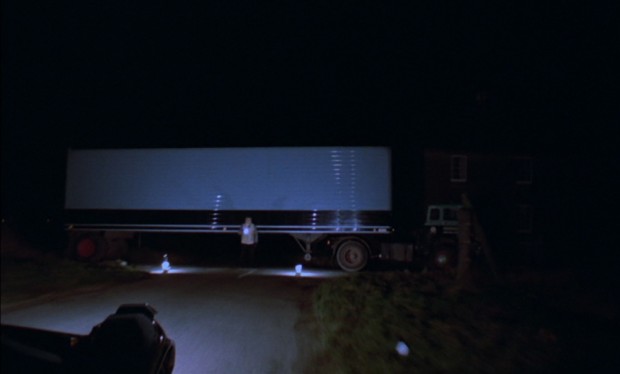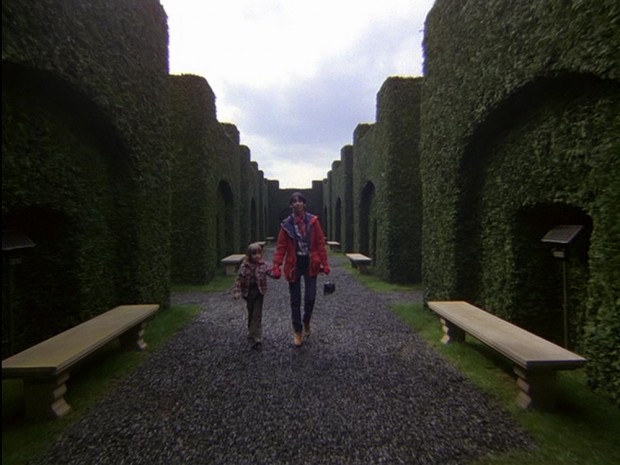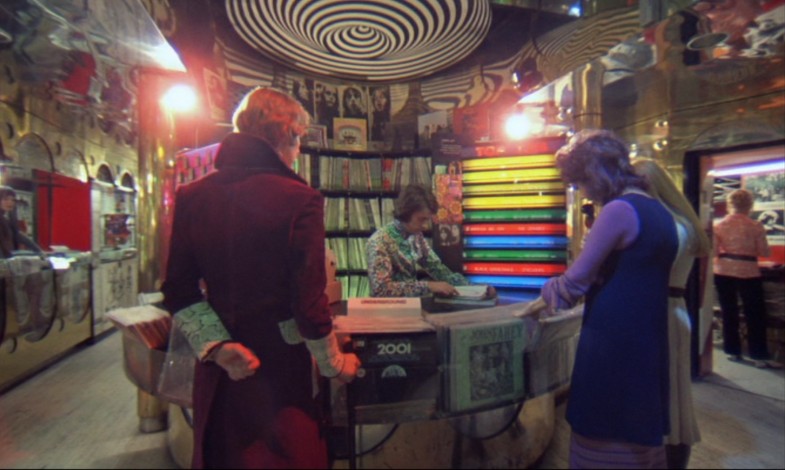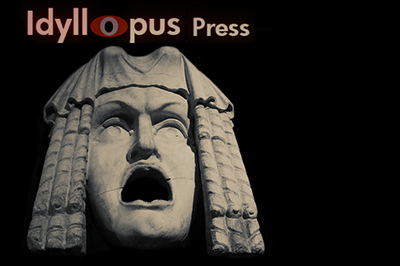STANLEY KUBRICK'S A CLOCKWORK ORANGE

Go to TOC for this film ( (which has also a statement on purpose and manner of analysis and a disclaimer as to caveat emptor and my knowing anything authoritatively, which I do not, but I do try to not know earnestly, with some discretion, and considerable thought).
PART TWO
TOC and Supplemental Posts | Part 1 | Part 2 | Part 3 | Part 4 | Part 5 | Part 6 | Part 7 | Part 8 | Films Home
LINKS TO SECTIONS OF THE ANALYSIS ON THIS PAGE:
Alex's Home, Shots 93 through 137
18 A Linear North and the cubist blackboard. The mural. Alex's bedroom and HOME. Alex's thieving of clockworks. The relationship of Cat Ballou to A Clockwork Orange and use of imagery from. The theatrical dancing Christs. Vampirism and blood religion.
One Million Years B.C.
Dracula and the Frankenstein of Lolita.
A Pain in the Gulliver, Shots 138 through 152
The golden apartment. Beethoven's death portrait alongside the "breathing" Beethoven. Decoding the tumbler lock. The roulette wheel. Mr. Deltoid and the extra set of teeth.
The Little Things
The Parting of the Earth
The March Through the Drug Store, Shots 153 through 154
Love is Colder Than Death. The relationship of Fahey's The Transfiguration of Blind Joe Death to A Clockwork Orange.
Der Rosenkavalier, Love is Coder than Death, and the Chelsea Drug Store
"Ned Kelly" and the Sculptural Suit at HOME
The William Tell Overture and the Invisible Bowman, Shot 155
The rainbow phallus women as a gate to change, as with the rainbow women in Eyes Wide Shut.
Gillian Hills, the Threesome, and Blow-Up
Funeral Parade of Roses, its Oedipal theme, bloody eyes, and the equating of cinema with drugs for the eyes.
ALEX'S HOME
18 A LINEAR NORTH AND THE CUBIST BLACKBOARD - THE MURAL - ALEX'S BEDROOM AND HOME - ALEX'S THIEVING OF CLOCKWORKS - THE RELATIONSHIP OF CAT BALLOU TO A CLOCKWORK ORANGE AND USE OF IMAGERY FROM - THE THEATRICAL DANCING CHRISTS - VAMPIRISM AND BLOOD RELIGION - ALEX'S VISION HAS HIM ALREADY ATTIRED IN HIS BLUE SUIT
93 LS Alex exterior municipal flat blocks. (16:48)
Early dawn. Cut to the exterior of the project where Alex lives, a modern development that, with its austere exterior architecture, could be viewed as a bloated, unrelenting version of HOME, but trashed out, desolate, furniture and garbage littering the communal plaza. Where the stark lines of HOME in an idyllic country setting create an individual environment suggesting serene meditation, the municipal flat block is instead only severe and chaotic.
The music for the Funeral of Queen Mary plays, we having returned to it with the droogs at the milk bar following their long night of carousing.
ALEX (VO): Where I lived was with my Dada and Mum in municipal flat block 18-A Linear North.
The blue light beyond the apex of the triangle in the concrete common recalls the hint of blue light vanishing point observed exterior the tunnel with the assault upon the bum. I've my doubts that this blue light eventually lining up directly with the pyramid would be anything but intentional on Stanley's part. There are other purposeful triangulations in the film. The one everyone remembers is in the prison yard. The first triangulation is actually via perhaps some sequins or crystals bouncing back light off the pubic hair surrounding the vaginal area of one of the mannequin tables, a triangle formed. The lights before the mack truck in the road formed another triangulation which Alex ignored and zipped the Durango through and under the truck.
94 MS Interior mural of municipal flat block lobby. (17:03)
There is a shift in tone as Alex enters his building. Though the electronic music continues, we now have Alex's whistling accompaniment, and the general sound tableau is more intimately mundane.
Lording over the entrance area is a large non-art mural that is supposed to give the impression of Greco-Roman classical whatever style, partially nude men working along the riverfront. We see workers handling cattle, some kind of sea life (a sturgeon?), and wood for use in construction. Two white birds fly above the scene, perhaps seagulls, but at least one resembles a dove. In the background of the mural we view buildings from Industrial Anywhere spewing streams of smoke out of their chimneys. The impression of the mural is that it defines for the residents of the apartments their role in society as laborers and encouraging them in acceptance of their lot, dignifying that lot by association with the working class of the Roman Empire, embedding the propaganda in what is intended to be recognized and accepted as art by virtue of its faux classical style, uninspired, plotted to be at a level suitable for the understanding of the masses. The figures painted against gold, the mural even thus communicates the workers as belonging to a Golden Age. Belying this rosy outlook, the mural is covered with graffiti genitals and bubble comic dialogue: "If it moves kiss it", "Give me a kiss", "Ouch that hurt".
We see to the right in the mural, peeking over the wall, the omnipresent Kilroy, which was first glimpsed in a poster at the milk bar, or even before that in Alex's distinctive long phallic nose mask.
A young woman carrying a barrel, milk dripping from her breasts, has the dialogue bubble, "Suck it and See", which seems less like staging than an admonition.
Alex, climbing over a trashed, potted tree, finding the elevator broken, trudges through trash to a stairway, passes a bra hanging on one of the bannisters. Climbs on.

Alex is certainly not the only young hooligan running about from the look of things, and the state has abandoned the area to filth with either no or very little custodial care of the buildings or grounds.
95 MS Interior bathroom of Alex's apartment. (17:43)
The first view we're granted of Alex's home is the bathroom with its diamond print wallpaper. He's taking a leak and one imagines every action in the bathroom fuzzily, unavoidably reflected in the mirrored diamonds, the gaudy, mod wallpaper assuring the residents that they too are prosperous, not left behind, as evidenced by the contemporary decoration of their home and their ability to partake in trends.
There was something in almost every scene guaranteed to shock the audience of the time: the hyper-sexualized mannequins in bondage in the milk bar, the graphic frontal nudity of the female assault victim at the casino, the phallic mask and Alex's dangling genitals in the HOME scene, and now Alex unselfconsciously peeing before the camera. For though the audience knew they were watching a fiction, a character, they would feel especially present here with the way the scene is so mundanely filmed, the viewer becoming an unintentional voyeur.
96 MS Interior Alex's bedroom, Alex in the mirror. (17:47)
Alex's bedroom, as we shall see, appears to belong less to this apartment than to the HOME he'd invaded earlier--as if he should have been a child of Alexander and a previous wife, a teen trenched in his personal habits, staking out his individuality, yet showing much of the aesthetic DNA of the HOME family, not to mention the income that would avail Alex the style to which he's accustomed in the privacy of his working class bedroom.
And yet, Alex is no fourteen-year-old teen, as he was in Burgess' book. McDowell is a mature adult, there is no excuse of excessive youth for him (Burgess, at the end of his book, blames Alex's criminal behavior on his just being a kid). Though Alex is portrayed as school age, and we tend to accept that without much trouble, Kubrick successfully scrambling early on the boundaries of youth and maturity, he is still communicated here as being a young adult rather than a boy on the verge of manhood. Of course it didn't hurt that the audience knew McDowell from his part as a rebellious schoolboy in the 1968 film If.... and could draw a youthful association.
Kubrick chose to show us first the bathroom, and now he skips over the rest of the apartment cutting directly to Alex's bedroom where we see him in the mirror removing the two eyelashes that frame his right eye, the bloodied eyeball on his shirt cuff standing out prominently and thus forming a link with Alex's eyes.
Alex's bedspread is a novel affair bedecked with sculptured yellow and orange "breasts" composed each of 6 raised pieces of fabric forming a cone. Over his single bed hangs what appears to be a large globe light, the largest of the globe lights thus far seen, but come morning we shall see it is instead the light of a small bulb reflected by a metal pan/backing. Beside it, to the rear of him is black and white graphic art of a woman lying back on a table, holding up her legs to reveal the area where should be her vagina yet there is none visible, but then that area is also hidden by a branch mounted to the wall beside the art, the branch extending suggestively up between the legs. A heat lamp shines down on the branch from above, the reason for this to soon be revealed when we learn Alex has a snake and this is his snake's perch. So, for Alex, snake equals phallus.
I'm aware that Kubrick has said he added in the snake when he realized McDowell was afraid of snakes, but I wonder about this as Kubrick gave HOME certain Eden-like elements with its sense of peaceful isolation and the large garden adorning the wall in the form of a painting. Here we have some critical Christian and Jewish symbolism clumped all together with the dancing Christs positioned directly below the perch of the snake which tempted Eve with knowledge.
On the shelf before the mirror is a red typewriter, connecting again Alex with the writer, Alexander, who also had a red typewriter. It is a smaller, portable model, presenting Alex as the little Alex to the writer as the greater Alex.
The wall to the left of the mirror is covered with speakers for Alex's stereo system which at that time was state-of-the-art. How else could he afford it but to purchase it with ill-got lucre.
Having put his false eyelashes on his mirror, Alex jumps back on his bed. The scene, with its music, is almost pacific.
97 MS Alex's loot drawer. (18:06)
A shot from above of Alex opening his drawer of plundered loot and emptying his pockets into it. We see money and cigarette cases and cameras, but most of all we see time pieces, an emphasis perhaps placed on these because of the idea of the clockwork orange. He deposits in the drawer yet another gold watch, which must be from the house of the writer, and quite a large wad of cash.
Thieving magpie, I guess.
98 MS Alex's bedroom, Alex seen in the mirror. (18:13)
Alex climbs off the bed.
99 MS Alex's snake drawer from above. (18:17)
Alex checks on his snake kept in a drawer also below the mattress.
100 MS Alex, from the rear, seated before his mirror and sound system at the edge of the bed. (18:25)
Alex takes a cassette out of the player. To the left we see a yellow bag. The only letters we can read on it GER.
ALEX (VO): It had been a wonderful evening and what I needed now to give it the perfect ending was a bit of the old Ludwig Van.
101 CU Alex's hands holding a cassette. (18:33) A close up of the cassette. "Symphonie Nr. 9, d-moll, op. 125"
102 MS Alex, from the rear, seated before his mirror and sound system at the edge of the bed. (18:38)
Shot 98 | Shot 99 |
 |  |
Shot 100 | Shot 101 |
 |  |
Shot 102 | |
 | |
103 CU Alex's hands removing one cassette and replacing with another. (18:40)
Alex removes a Goggly Gogol cassette and replaces it with the Beethoven.
In shot 100 Alex had already removed the cassette in the player, yet here he is removing it again.



Gogol was mentioned in the novel, just once, at the record store. Was Burgess making an allusion to Nikolai Gogol and Dead Souls? I can't see anything to indicate that. Kubrick found the name useful enough to keep and used it both here and at the record store. As goggle is to stare with wide, bulging eyes, my mind returns to Alexander goggling the rape of his wife, and then I leap forward to thinking of Alex's eyes pinned open so that he is unable to close them during the brainwashing that would purport to make him a nonthreatening human fit for return to civilization.
104 MS Alex, from the rear, seated before his mirror and sound system at the edge of the bed. (18:42)
Alex cuts on the music and looks at himself in the mirror with a self-satisfied expression.
105 MS Beethoven window shade. (18:46)
A large black and white image of Beethoven is printed on the window blind of Alex's room. It moves as with the breeze as the music begins. The camera zooms in on his intense gaze.
Rather than the tape starting with the first movement, it begins with the second, the scherzo.
Shot 104 | Shot 105 |
 |  |
106 MS The art work of the woman. (18:52)
As the camera begins to pan down, cut to the art of the woman with the spread legs, the camera panning down over Alex' snake climbing over a branch between her legs. The camera continues panning down to show on the dresser below a sculpture chorus line of four dancing, white, fair haired Christs with thorns around their heads, their sides and wrists pierced.
And we realize that the bloodied eyes on Alex's wrists have all to do with the pierced wrists of Christ.
The everyday viewer of the 60's would have been so taken aback by the dancing Christs with their dangling penises (porcelain figures by artist Herman Makkink, who also did the "Rocking Machine" penis at the cat woman's house) that it's likely not much thought would have been given as to the character of Alex and his possession of this sculpture, how it would have been selected by him and have meaning for him. And the notion that Alex would have purposefully purchased it to decorate his room, placing it under the snake perch, is a very interesting and meaningful bit of Kubrick notation on his character that ties him to the cat woman.
107 CU Bleeding head of thorn-crowned Christ. (19:15)
108 CU Nailed wrist of Christ. (19:15)
109 CU Nailed feet of dancing Christs. (19:15)
110 MCU Busts of the dancing Christs. (19:16)
111 MCU Nailed feet of dancing Christs. (19:17)
112 CU Bleeding head of thorn-crowned Christ. (19:17)
113 MCU Chorus line of dancing Christ. (19:17)
114 CU Bleeding head of thorn-crowned Christ. (19:19)
115 CU Nailed wrist of Christ. (19:19)
116 MCU Busts of the dancing Christs. (19:20)
117 CU Nailed wrist of Christ. (19:20)
118 CU Bleeding head of thorn-crowned Christ. (19:21)
119 MCU Nailed feet of dancing Christs. (19:21)
120 MCU Chorus line of dancing Christs. (19:22)
121 CU Nailed wrist of Christ. (19:22)
122 CU Bleeding head of thorn-crowned Christ. (19:23)
123 MCU Nailed feet of dancing Christs. (19:23)
124 MCU Chorus line of dancing Christs focusing on the lance mark in the chest. (19:24)
125 CU Nailed wrist of Christ. (19:24)
126 CU Bleeding head of thorn-crowned Christ. (19:25)
Shot 107 | Shot 108 |
 |  |
Shot 109 | Shot 110 |
 |  |
Shot 111 | Shot 112 |
 |  |
Shot 113 | Shot 114 |
 |  |
Shot 115 | Shot 116 |
 |  |
Shot 117 | Shot 118 |
 |  |
Shot 119 | Shot 120 |
 |  |
Shot 121 | Shot 122 |
 |  |
Shot 123 | Shot 124 |
 |  |
Shot 125 | Shot 126 |
 |  |
127 CU Alex. (19:25) Cut to Alex staring on in a kind of demented rapture.
ALEX (VO): Oh, bliss, bliss and heaven. Oh, it was gorgeousness and gorgeosity made flesh. It was like a bird of rarest spun heaven metal, or like silvery wine flowing in a spaceship, gravity all nonsense now, as I slooshied...
128 CU Beethoven window-shade. (19:48)
ALEX (VO): I knew such lovely pictures.
129 LS from below hangman's galley. (19:50)
Cut to a hangman's galley from below as the trap opens and a woman in white bridal costume or simply a long dress drops down, her petticoats whirling, men looking on from above.
130 CU Alex with bloodied vampire fangs. (19:53)
131 LS Explosion, mostly earth. (19:53)
132 CU Alex with bloodied vampire fangs. (19:56)
133 LS Fiery explosion of a train. (19:57)
134 CU Alex with bloodied vampire fangs. (19:58)
135 LS Old movie footage of boulders raining down on cave men. (19:58)
136 CU Alex with bloodied vampire fangs. (20:00)
137 Another fiery explosion. (20:01)
Shot 127 | Shot 128 |
 |  |
Shot 129 | Shot 130 |
 |  |
Shot 131 | Shot 132 |
 |  |
Shot 133 | Shot 134 |
 |  |
Shot 135 | Shot 136 |
 |  |
Shot 137 | |
 | |
The vampire image of Alex finds him wearing the dark blue jacket of the suit he wears either while incarcerated or when he is entered into the prison system.
I read at Wikipedia on the film Cat Ballou that "imagery from the hanging scene of Jane Fonda was used in sa spoof advocating her execution for treason following her 1972 visit to Hanoi" and that a brief shot from the scene is this one of the hanged woman in Alex's fantasy. In Cat Ballou, just as the trap door opens, one of her gang cuts the hanging rope, and the next image is the trap door opening from beneath and Cat dropping down, only she is rescued and escapes because of the rope having been cut. In the footage shown in Alex's fantasy the woman instead bounces and appears to have been hung, though it's the stuntman in his harness and we've a brief view of his face. This would be a shot used in the spoof because the stunt man's hand reaches immediately out as he falls and that extended hand isn't seen in Cat Ballou. The footage would have had to have been cutting room floor scraps rather than simply spoof footage as it is an exact match in every way with the film.
The story of Cat Ballou concerns a corporation attempting to grab the ranch of Catherine (Cat) Ballou's father. She hires a famed gunfighter to protect her father from Silvernose, a hired killer who also threatens her. Lee Marvin plays both Silvernose and the "good" but drunken Kid Shelleen who reforms for a brief time, his confidence bolstered with his belief that Cat loves him. Cat becomes an outlaw when her father is killed by Silvernose and he isn't brought to justice. Shelleen does eventually kill him, but Cat isn't done seeking revenge. She confronts and accidentally kills (if I remember correctly) the head of the corporation who had stolen her father's ranch, for which reason she is on the gallows at the film's end.
It's revealed at one point that Silvernose and Shelleen are twin brothers. All of this is to be taken into consideration in respect to Alex's scene with the Cat Woman, his self-identified (facetiously) "brother", Alexander, and the twin perfected Christian self that is programmed via the brainwashing.
But how interesting that Kubrick has here footage used in a spoof calling for Jane's execution, as if to comment on the bloodthirstiness of it. With the explosions that follow Kubrick appears to link such blood thirstiness with sexual arousal, but there are other meanings as we shall later see.
There's plenty enough to outrage people in Alex's bedroom, especially for the sixties. The sculptured chorus line-up of dancing Christs with penises would have been enough to send a good chunk of the population through the roof, as well the associated suggestion that Christianity is a bloodthirsty religion. Eve and the snake, at least in Christianity's book of traditional literalism, leading to the fall of humankind, necessitated the death of a human-god bearing the sins of the world and yet absolutely innocent. The sacrifice of the son of god unceasingly mourned, yet the sacrifice of which is just as unceasingly thirsted after, replayed yearly, isn't culturally so far removed from the vampiric Alex drawing life from violence against others, especially considering the Mass and its communion, the eating of the host, the drinking of the blood in the celebration of sharing in the renewing life of a slain and risen god.
Redemption comes by blood.
How did the requiem prayer run?
In the midst of life we are in death,
of whom may we seek for succour
but of thee, O Lord,
who for our sins art justly displeased?
Yet, O Lord, O Lord most mighty,
O holy and most merciful Saviour,
deliver us not into the bitter pains
of eternal death.
Thou knowest, Lord,
the secrets of our hearts,
shut not Thy merciful ears unto our pray'rs;
but spare us, Lord most holy,
O God most mighty.
O holy and most merciful Saviour,
Thou most worthy Judge eternal,
suffer us not, at our last hour,
for any pains of death,
to fall away from Thee.
Spare Thy people
whom Thou hast redeem'd
with Thy most precious blood,
and be not angry with us for ever.
Spare us, good Lord.
ONE MILLION YEARS B.C., DRACULA AND THE FRANKENSTEIN OF LOLITA
I'll return later to the subject of Cat Ballou. Right now I'd like to speak briefly about One Million Years B.C., the film from which was taken the footage of the rock avalanche burying primitive men, which is included in the below trailer for the film.
The below voice-over is given as the avalanche occurs.
One Million Years B.C. erupts on the screen with volcanic excitement. One million years B.C., when the earth parted, and the mountains fell...
When the earth parted...that may be the most salient text.
One will think of Kubrick's 2001 and the ape-men struggling to survive, that this could reference that. Which I imagine it does. And we would possibly also have an overlay of commentary on the sexual and violent nature of such films as One Million Years B.C., the eruptions possibly having much to do with Raquel Welch, and yet they are glossed and cloaked in such a manner that they aren't shocking, but A Clockwork Orange was, with Alex's vampire teeth and his obvious mesmerized delight in his imagination's violent "pictures". One might sense commentary on both the industry and the audience and their thirst for this violence and bloodletting and the sexual arousal had not only with Raquel but with the violence.
One Million Years B.C. was put out by Hammer films and that studio was known for what else?

Yeah, right, of course. Christopher Lee as Dracula.
Kubrick was certainly Hammer savvy. He created the scene in Lolita in which Humbert Humbert goes to the drive-in theater to watch Hammer's The Curse of Frankenstein with Lolita and her mother, the implication being that Humbert was secretly the monster. This was not in the book.
I write of it in my analysis on Lolita:
Not included in Kubrick's movie, Nabokov had as an epilogue Lolita giving birth to a stillborn child and herself dying during birth. Mary Godwin Shelley, before authoring Frankenstein, had also had a child die, born prematurely, who had survived for two weeks. She soon thereafter had another child, who was about five months old when she had the "waking dream" which became the foundation for Frankenstein and his monster. Some suggest that Mary's loss of her first child and her guilt over it was also an inspiration for the novel, others that Frankenstein's model was her lover/husband Percy who, having an affair with Claire, Mary's stepsister, went away with Claire for a day immediately after the infant's death. There are a number of theories--my interest here is that Kubrick has chosen to use The Curse of Frankenstein as the film seen by Charlotte, Lolita and Humbert, and that with Lolita we have the death of a child in the novel and screenplay while in Frankenstein we have it in the author's life.
In A Clockwork Orange Kubrick has, on one level, Alex being the necessary monster born of destiny (Christ needing his persecutor), and on another level played with Alex also being the monster child of Burgess, while Burgess himself had Alex Delarge finding "HOME" with the writer, Alexander, where he assaulted his father figure and raped his wife, again a kind of Oedipus who couldn't escape fate. In 2001, HAL, too, is a kind of monster child of his creator humans, a twin who somehow goes rogue.
Kubrick returns to Hammer horror but it is now Dracula, the immortal (almost) who thrives on blood--much like regular, everyday humans, and the gods, too, who demand blood, such as the blood of the dancing Christ. Or humans imagining their gods demanding this blood and inventing them in their image.
What draws my attention, however, is that Kubrick has chosen the image that accompanies the text, in the trailer, of the "parting of the earth". For Kubrick often has these division points in his films. In The Shining it is the continental divide upon which the Overlook is located according to the two Montana drives up to it (I write of this in that analysis). In Eyes Wide Shut I think Greenwich supplies that divide. In 2001 we eventually see the divide is the monolith standing at the point where reflecting symmetrical halves meet.
A PAIN IN THE GULLIVER
THE GOLDEN APARTMENT - BEETHOVEN'S DEATH PORTRAIT ALONGSIDE THE "BREATHING" BEETHOVEN - DECODING THE TUMBLER LOCK - THE ROULETTE WHEEL - MR. DELTOID AND THE EXTRA SET OF TEETH
The Beethoven continues, unbroken.
138 LS Interior hall of the apartment, Alex's mother entering and knocking on Alex's door. (20:02)
Morning. Cut to the hallway outside Alex's bedroom ending in the entry hallway of the apartment. The walls are all spackled in gold paint continuing the theme of this being a Golden Age as depicted in the mural in the building's lobby. At the end of the hall is a bureau upon which is set a fake plant and above that a kitschy painting of a partly nude woman. Alex's mother is wearing clothing that, curing the time, was associated with youth, for which reason it all appears too youthful on her--yellow knee socks, black vinyl jumper and shirt, purple wig. Having entered the hall, she knocks on Alex's door. Her costume and concerted naivety make Alex's violence seem less outrageous.
MUM: Alex. Alex? Alex! (Knocks again.) Alex!
139 LS Alex asleep in his bed. (20:17)
Cut to Alex asleep in his bed under a red-orange blanket on blue sheets, the snake on his bed. We see on the blue cabinet behind him a death portrait of Beethoven. Alex's sleeping pose, though different, could be said to echo it.
The image of Beethoven in the window bears a resemblance, in its severe brow, to the writer, Alexander. This is significant, as well as the death image of Beethoven nearby, for later in the film Alex attempts to leap to his death through an attic window while Alexander sits in a room below eagerly awaiting this expected move. The two images form their own duality, the living, breathing Beethoven to one side (suggested with the moving shade) while next to it we have the static death portrait.
The large white bulb that hung over the bed the night before appears to be gone, replaced by a smaller bulb emerging from the center of a large silver, convex disk the same diameter as had been the larger bulb. But this is an illusion. The brilliance of the light the night before was caused by the reflection off the metal which only made the bulb appear to be bigger.
The appearance of the switching of a great light for the smaller one continues in the vein of expressions of the greater or larger Alex and the smaller one, the thug, as we have seen with the typewriters. Also, at Alexander's home, there had been the larger orange sphere on the bookshelf, then when Alex and his droogs had entered a smaller orange sphereoid object had appeared on the same shelf. Later, when Alex is in prison, we will learn that his name is Delarge and there is then some blurring in distinguishing the older Alexander, who we've thought of as the greater Alexander, from Alex the thug, who we've thought of as the lesser.
MUM (knocking): Alex!
The Beethoven window shade puffing, "What do you want?" Alex calls to his mother.
MUM: It's past eight, Alex. You don't want to be late for school, son.
ALEX: Bit of a pain in the gulliver, Mum. Leave us be and I'll try and sleep it off, and then I'll be as right as dodgers for this after.
140 LS Mum before the door. (20:36)
MUM: But you've not been to school all week, son.
ALEX (VO): Got to rest, Mum.
141 LS Alex in his bed. (20:42)
ALEX: Got to get fit. Otherwise I'm liable to miss a lot more school.
MUM: I'll put your breakfast in the oven. I've got to be off meself now.
ALEX: All right, Mum. Have a nice day at the factory.
Can we imagine Alex buckling down, at this point in his life, and accepting a factory job existence?
No. Decidedly no.
Shot 140 | Shot 141 |
 |  |
142 LS Kitchen, Alex's father sitting at the table. (20:59)
Cut to the small kitchen/dining area which is wallpapered with yellow, orange-red and mirrored metallic squares, poorly applied and wrinkled, a toy sunflower cheerily smiling on the table before the window, informing us the day is good after all, despite all, never mind all. The sunflower appears also to be taking the place of Alex, the son, his chair beside it. The mum enters from the left and seats herself on the right, opposite the father.
The kitchen is all squares while directly to its left we have the living room wall which is all sphereoids, reminding of the blackboards at HOME with the spiral on one and the squares on the other. The bathroom wallpaper also had mirrored diamond shapes.
MUM: He's not feeling too good again this morning, dad.
DAD: Yes, yes, I heard. Do you know what time he got in last night?
MUM: No, I don't. I'd taken me sleepers.
143 MS Dad. (21:15)
DAD: I wonder where exactly is it he goes to work of evenings.
144 MS Mum. (21:22)
MUM: Well, like he says, it's mostly odd things he does, helping like, here and there as it might be.
Shot 143 | Shot 144 |
 |  |
Alex's mum, taken alone, is sad, but paired with her husband the two are devastating in their complacent, submissive inertia. The gaudy decoration of the apartment doesn't seem singular, one imagines the whole block as being similarly clashingly outfitted and reminds of fast food joints that conspire with their decorations to get the food down you and you out as quickly as possible. As a renting resident you've no choice but to live with insanely obtrusive interior design choices which so own the apartment that there's little opportunity to impose any personal aesthetic.
Alex's room being an exception. He owns that.
And he's making sure no one gets in.
145 CU Tumbler lock. (21:33)
Cut to a tumbler lock on a door. 17. 34. 89. The camera zooms out as Alex opens the door to his room, letting himself out, the glaring face of Beethoven behind.
Remember the missing roulette wheel in the roulette wheel table at the casino? 17 and 34 rest beside each other on a European roulette wheel.
What of 89? The numbers on a roulette wheel only go up to 36. What if we try 8 and 9 individually? They are related to each other. To either side of 8 are the numbers 30 and 23 which add up to 53. To either side of the 9 are the numbers 31 and 22 which add up to 53.
89 minus 36 (as high as the numbers on the roulette wheel go) is 53.
Wikipedia reads, "A legend says that François Blanc supposedly bargained with the devil to obtain the secrets of roulette. The legend is based on the fact that the sum of all the numbers on the roulette wheel (from 0 to 36) is 666, which is the "Number of the Beast".
Eventually, Alex will be identified with the number 666 (when Georgie and Dim, as police, take him out to torture him, one will have the number 665 on his uniform and the other will have the number 667, and Alex will be positioned between them) so there may be indeed a relationship between the casino roulette wheel and Alex's tumbler lock, which I just had a hunch on.
The only other time a 53 appears with this method is with the adding of the two numbers either side of 1. 51 19 40 6 46 19 69 23 61 29 63 24 66 19 53 18 28 34 21 57 17 53 15 23 53 27 51 25 57 19 63 15 61. But I can't make anything out of the choice of 89 or 8/9. If you start playing number games, 53=8 and of course those 3 58s become 24=6. But that will take us nowhere.
I pay attention to the roulette because in The Shining Danny is playing darts when the girls appear to him. And we have 237 on the dart board. There are 20 numbers on a dart board and in the bottom of the board we have 2 17 3 19 7, 237 separated by 17 and 19.
There are no consecutive numbers on the roulette wheel, but if you do as I have done to get those 53s then you end up with 3 consecutive numbers beside those 53s, and it only happens I think with the 53. The consecutives are 17, 18 and 19. There is no 16 or 20 by my meaningless method. And the sum of 17 and 18 and 19 is 54.
Blaise Pascal, a mathematician from whom we have the Western Pascal's Triangle and probablity theory, wanted to build a perpetual motion machine. Instead he came up with a primitive version of the roulette wheel. How'd that happen? Who added the numbers to the wheel? Francoise Blanc (the guy said to have made the deal with the devil due the 666). Why were the numbers arranged on it the way that they are? No one seems to know other than they are supposed to produce purely random results. The wheel isn't symmetrical because of the incorporation of the 0. Adding up the 18 numbers on each side of the 0 on the roulette wheel the result is 333 for each side but there's no finding any particular order after that except that the divisors of 36 are as evenly distributed as they can be, there being 9. 3 in one quadrant and 2 in each of the other quadrants.
36 is a triangular number. As is 666, which is the 36th triangular number.
Francois Blanc was called the Magician of Monte Carlo (and Homburg). His daughter married a Bonaparte, a relative of Napoleon. Kubrick was going to do that movie on Napoleon so he probably studied Francois Blanc as well.
Again, if I pay attention to any of this it is because of (1) the dart board in The Shining and (20) because Kubrick will later numerically associate Alex with 666, and the roulette wheel is associated with 666 as well.
Now I shall step away from Alex and his lock. Step away. Step away.
Oh, wait, I get it now. 17 x 2 = 34. So the 2nd number in the series doubles the first. I already knew that, and one expects the third number to be doubled but it's not. But it is! The third number? It doubles, but only when flipped. 34 x 2 is 68. Flip the 68 and you have 89.
146 MS Alex from behind.
We track him down the gold hall to the right, on his way to the living room with its blue carpet and pink-red ceiling, scratching his rear, and as he passes a bedroom on the left, turning off the hallway light to the right of it, we see a man seated on a bed within that bedroom. Alex, however, hasn't consciously noticed. Not yet. In the living room he faces the plate glass windows. And now it hits him, that there had been a man in the room, and he returns to it.
147 MS from behind Deltoid in the bedroom, Alex in the hall. (22:09)
The Beethoven ends.
ALEX: Hi, hi, hi, Mr. Deltoid. Funny surprise, seeing you here.
148 Mr. Deltoid. (22:18)
Mr. Deltoid, wearing a trench coat, is seated on Alex's parents' bed--and, seated on that bed, becomes a stand-in father figure. The bedroom is hot pink and the cheap bedspread covering the mattress and pillows is the color of grass. A set of false teeth is in a glass on the nightstand beside him. Mum's many wigs on wig heads line a dresser top to the rear, before the window which has green curtains.
MR. DELTOID: Ah, Aleck, boy. Awake at last. Yes? I met your mother on the way to work. Yes? She gave me the key. (He tosses the key on the nightstand.) She said something about a pain somewhere, hence not at school. Yes?
149 MS from behind Deltoid, Alex in the hall. (22:37)
ALEX: A rather intolerable pain in the head, brother, sir. I think it should be clear by this after lunch.
It's a bit interesting that the lock is followed by the key. In the book, Alex is woken from a dream by the doorbell and lets in Deltoid.
Shot 145 | |
 | |
Shot 146 | Shot 147 |
 |  |
Shot 148 | Shot 149 |
 |  |
150 Mr. Deltoid. (22:42)
MR. DELTOID: Mmm, or certainly by this evening, yes. The evening's the great time, isn't it, Alex boy? Hmmm?
ALEX: A cup of the old chai, sir?
MR. DELTOID: No time, no time. Yes. (He pats the bed beside him.) Sit, sit, sit!
Alex enters and sits.
ALEX: To what do I owe this extreme pleasure, sir? Anything wrong, sir?
Deltoid, the father figure, reaches his arm around Alex to rub his hair as one would a child, shifting to gripping it in a hard yank.
MR. DELTOID (rubbing Alex's head): Wrong? Why should you think of anything being wrong? (His grip on Alex's hair, he pulls it.) Have you been doing something you shouldn't, yes?
ALEX: It's just a manner of speech, sir.
One senses Deltoid has more muscle with Alex than his parents who have probably, long ago, left him to the state.
MR. DELTOID: Yes, well it's just a manner of speech from your post corrective adviser to you, that you watch out little Alex. Because next time it's not going to be the corrective school any more. Next time it's going to be the barry place and all my work ruined. If you've no respect for your horrible self, you at least might have some for me, who sweated over you. A big black mark (he slaps Alex's knee hard, reminding of how Alex had popped Dim's thigh the night before) I tell you, for every one we don't reclaim. A confession of failure for every one of you who ends up in the stripee hole.
ALEX: I've been doing nothing I shouldn't, sir. The millicents have nothing on me, brother, sir, I mean.
Deltoid yanks Alex down on the bed and holds him there.
MR. DELTOID: Cut out all this clever talk about millicents. Just because the police haven't picked you up lately doesn't, as you very well know, mean that you've not been up to some nastiness. There was a bit of a nastiness last night, yes? Some very extreme nastiness, yes? A few of a certain Billy Boy's friends were ambulanced off late, yes? Your name was mentioned, the words got through to me by the usual channels, certain friends of yours were named also. Oh, nobody can prove anything about anybody as usual but I'm warning you, little Alex, being a good friend to you as always, the one man in this sore and sick community who wants to save you from yourself.
Punctuating how he wants to save Alex from himself, Deltoid socks Alex in the groin. Alex laughs, but as he sits up he hunches over in pain.
There is some question as to whether or not Deltoid is making a conscious or unconscious sexual grab for Alex. Even if it was explicitly sexual the action would still be power oriented, establishing dominance. Alex' pained reaction has me convinced the blow is intended to inflict pain, which isn't to say that Deltoid may not have been partly aroused by it. He seems less composed, following, and has to reorganize himself.
In section three I write on the Rocking Chair penis used in the Cat Woman section and how we can tie it back to this scene via the book, in which Deltoid instead sat in Alex's father's rocking chair rather than sitting on the bed with him. Kubrick adds a sexual component, the effects of which cascade into the Cat Woman storyline and become his undoing.
151 from behind Mr. Deltoid facing the hall. (24:33)
Alex rises from the bed and goes to stand by the door, recovering.
152 Mr. Deltoid. (24:39) Deltoid, straightening, sweating, agitated, infuriated with his lack of control over Alex, picks up the denture glass from the nightstand and drinks from it.
MR. DELTOID: What gets into you all? We studied the problem, we've been studying it for damn well near a century, yes. But we get no farther with all our studies. You've got a good home here, good loving parents, you've got not too bad of a brain. Is it some devil that crawls inside of you?
ALEX: Nobody's got anything on me, brother, sir. I've been out of the rookers of the millicents for a long time now.
MR. DELTOID: That's just what worries me. A bit too long to be safe. You're about due now, by my reckoning. That's why I'm warning you now, little Alex, to keep your handsome young proboscis out of the dirt. Do I make myself clear?
ALEX: As an unmuddied lake, sir. As clear as an azure sky of deepest summer. You can rely on me, sir.
Mr. Deltoid taking another drink, the clink of the dentures amplifies and Deltoid, sickening, realizes the dentures in the glass. He makes sounds of incipient nausea, searching his pockets for a handkerchief.
Shot 151 | Shot 152 |
 |  |
One may well wonder what are those dentures doing there? I've always thought of them as belonging to Alex's mother, though we've nothing to tell us they might. Both the parents had their teeth earlier. But they must belong to one of them. Who would have two sets of dentures? As we shall see, the teeth will link up with a painting later observed at the cat woman's house, a woman in the painting having two sets of teeth.
Deltoid was in Burgess' novel, and we have with the name the man associated with muscle, as in the deltoid muscle, but for Kubrick we would also have a continuation of the triangle/pyramid theme as delta is the fourth letter in the Greek alphabet, based on the Phoenician dalet (meaning door) which had as its symbol the triangle.
That the false teeth immediately follow after Alex in his vampire teeth is also of interest.
THE LITTLE THINGS
I just have to point this little thing out because I take such delight in stuff like this. The attention to detail.
In the approximate center of this pink room is a pink chair with a golden wire back. A circle in the middle gives an approximate center again, and through this we have wires passing that effectively divide the room into 4 quadrants.
What I love is the small detail that when Deltoid grabs Alex and pulls him back on the bed, Deltoid is arranged in such a way that he pretty much perfectly obscures 3 of the quadrants but the top quadrant is left exposed, the lines of his head and shoulder conforming to the outline of that quadrant. And he stays that way for a while.
I love stuff like that. Those petty little details. And I bet you anything that was purposeful.
THE PARTING OF THE EARTH
Concerning the pictures the music conjured for Alex, I had noted that the avalanche of rocks on primitive man, taken from One Million Years B.C., likely had a layer of reference to 2001 and Kubrick's depiction of early hominids. I had also spoken of how this particular shot occurs, during the trailer for One Million Years B.C., in conjunction with the voice-over on "the parting of the earth", and that it brought to my mind how the monolith ends up standing at a place of division, the joint of reflective symmetry.
This reflective symmetry was also expressed when the monolith first appears to the hominids, the viewer just isn't going to be aware of it as what is involved is a horizontal flip of the background, and you just don't notice it.
The Shining opens with this same idea in the simple reflective surface of the lake. As above so below.
Kubrick eventually ties this reflective symmetry into the maze, in particular the world maze that Jack sees.
Interestingly, perhaps coincidentally, we now see this reflective symmetry, the flip horizontal, in the bedroom of Alex's parents.
Where do we see it? Can you find it? It's perfectly ordinary and unremarkable and easily passes by.

It's in the burled wood of the armoire, which is in marked contrast to the grain of Alex's door, which Kubrick just supplied a close-up of moments before.

At HOME, in shot 55, we have pretty much an infinity of these reflections as well.
What carries Alex and his droogs HOME but the Durango (a Probe 16), one of the squashiest, lowest cars ever built, at 34 inches in height. The back wheels were only 13 inches and the front only 10. You don't really get that much of an appreciation for how low it is in the film, but you do in this wikipedia image from their Probe 16 page.

A flat little car to carry them through narrow spaces. Such as in shot 44.
Which is why I think Kubrick may have chosen the Probe 16 to be the Durango. Because of how low it was. He wanted a vehicle that would represent and communicate Alex and his droogs not just dangerously flying down the road but slipping through the cracks, as it were. The between. Remember what I wrote about the irony of their heading "west" and ending up at a house with a Japanese zen garden? In the east? It's like slipping through the crack to the other side, an invasion into territory where they didn't belong. As if they've found the door through which to pass and it was symbolized by the triangle of light before the mack truck.
We have this also with Wendy and Danny making their way to the center of the maze. Along their way to the center they pass a red triangle.

Then there they are, at the center of the maze.
THE MARCH THROUGH THE DRUG STORE
LOVE IS COLDER THAN DEATH - THE RELATIONSHIP OF FAHEY'S THE TRANSFIGURATION OF BLIND JOE DEATH TO A CLOCKWORK ORANGE
153 MS of a woman sucking a popsicle in a record store. (25:47)
Cut to a record store done all in reflective material, a blond woman in white sucking a purple, yellow and pink phallic ice on a stick, facing a brightly colored listing of the "Top Ten". On a wall behind her a sign reads "goods receiving office". The number one selection of the Top Ten is "Mass in G" by Goggly Gogol (given here instead as Goggl Gogol), the same music Alex had extracted from his stereo the previous night before putting on the 9th.
A mass! Alex had been listening to a mass, liturgial music, at some point before the previous evening's events, and had replaced it with the Beethoven on his return home.
Other music from the top ten: Really Play, by Johnny Zhivago; Sweaty Club by (T)he Humpers (the t is knocked down); Inside by Heaven Seventeen; Dogs An Cats by Bread Brothers; Switch Me On, by The Sharks; Downy, by The Glow Goes; Jelly Roll by (T)he Legend (again, the T is knocked down); Black Christmas, by Cyclops; Art Nouveau by Comic Strips.
The lights of the Top Ten pulse as the music begins, the 4th movement from Beethoven's 9th symphony, Ode to Joy, containing in it the same poem sung by the woman at the Korova. The music is the "March", the 9th synthesized.
Beyond the blond woman in white we see two others at bins, perusing albums, their backs to us. One of these, wearing a long, knit, purple vest, will shortly be revealed to be a friend of the blond.
The woman in white turns and goes to look at albums in bins on the opposite wall, left. We now are afforded a view of one of the albums in a bin behind her, The Time is Near by the Jeff Hartley Band, an American Indian with outstretched arms on the cover. Tunes on the album included: Morning Rain; From the Window; The Time is Near; You Can't Take it With You; Premonition; Another Time, Another Place; Change.
Alex enters now from the left, looking to the right and so appears to not notice the woman in white.
Fassbinder's Love is Colder than Death came out in 1969. Kubrick's A Clockwork Orange in 1971. I think it's very possible that Love is Colder than Death may have influenced Kubrick's use of electronic music in A Clockwork Orange and very specifically Alex's stroll through the record shop. Below is the supermarket scene in Love is Colder than Death. In comparison with Kubrick, it becomes most interesting at 42 seconds. The two characters are shoplifting at a supermarket.
| ... |
Love Is Colder Than Death - Supermarket.
Well, it used to be online. I'm leaving a black square as a placeholder in hopes it will make its way back online again.
Alex's street garb isn't always gang attire. He is decked out poshly in a purple 60s take on an Edwardian coat over a yellow shirt. Trim on the sleeves and pockets is a snake pattern. He continues past posters, a rack that reads "Chelsea Drug Store Presents Island" with records on display--a listing of the different albums observed in the store to be had here. He passes a sign on the left that reads, "You Need Bread" (would refer to the band). On screen right there next is a display table with numerous magazines including Vogue, M, and various music, theater, film and dance publications. As he continues in his striding stroll around the semi-circular counter, one of the magazines catches his eye, Cinema X, and he picks it up as he goes. He leafs through it briefly, then as he passes counters of album bins to screen left where are two female clerks, one of whom studiously eyes him, he places the magazine down with a nod--and my feeling has always been that she's suspicious of him potentially shoplifting and he's acknowledging that. As he places down the magazine, an album titled Stray appears in a right bin. He concludes his stroll at another semi-circular counter positioned under a black and white swirl of concentric circles, a take-off on the hypnotist's device. To his right is the woman with the long vest we'd observed from the rear at the scene's beginning, this time paired with her blond friend in white. To the right of them, again, is the Top Ten board. Between, prominently displayed, is an album with music tracks from Kubrick's 2001. Other albums displayed are Crosby, Stills, Nash & Young's Deja Vu and John Fahey's The Transfiguration of Blind Joe Death.
Deja Vu is siginificant as Kubrick's films are ruled by repetitions. Later we will have Alex revisiting scenes of old, causing deja vu, just as Bill revisited old scenes in Eyes Wide Shut, and Jack in The Shining expressed himself as experiencing a strong sense of deja vu at the Overlook.
The Fahey album, placed as it is, next to 2001 is of interest, considering its liner notes:
A disgusting, degenerate, insipid young folklorist from the Croat & Isaiah Nettles Foundation for Ethnological Research meandered mesmerically midst marble mansions in Mattapan, Massachusetts. It was an unsavory, vapid day in the summer of 2010 as the jejune air from Back Bay transubstantiated itself autologically and gradually into an ozone-like atmosphere.
With the 2010, we've a permutation of 2001. Futuristic. So, to look more at the album, we learn its title memorializes a blues artist by the name of Blind Joe Death, and for a number of years he was given as being a real person who was Fahey's mentor, but was instead fictional and Fahey's alter ego.
Continuing on with the liner notes.
Knocking on a random door, haphazardly, the tasteless young man pondered the Hebraic inscription on the marble-tiled foot-brush, soporifically: "I wonder what the hell that means," he said to himself reflexively. The foot-brush backed itself into a corner at bay, with its back to the wall. Then, hissing at the wishy-washy young man, it reared up on its hind leg & stared into space, vociferously & stolicly. At this juncture a somewhat equivocal shoe-shine man opened the door, munching on a vacant popsicle stick. Before greeting the young man he reached up with a tentacle and stroked the aging foot brush on its fore, thus quieting the beast's existential anxiety.
Popsicles and Hebrew inscriptions. Kubrick may have been aware of the content of the liner notes. We've the women in the music store sucking on popsicles and Hebrew references can be found in Kubrick's films.
The liner notes, which go on at length, eventually sort themselves out as having something to do with the death and mythical resurrection and assumption of Blind Joe Death in 1962. A new order is to be enstated, state sanctioned, a religion that keeps "the masses guilty, docile and subservient. You know--opiate of the people and all that Thus--the cult of DEATH!"
There was no resurrection of Death, but Fahey is still alive and clones of him are being hypnotized to know the music and carry it all over the world.
A Clockwork Orange has everything to do with religion as a death cult, so the inclusion of Fahey's album suits it well and provides commentary.
John Fahey's "Dance of Death" had been used by Antonioni in his 1970 Zabriskie Point, and we have standing with Alex a reference to Antonioni's Blow-Up, which I will write about in a minute.
Kubrick's use of music of the time and the normal dress of the individuals shopping and clerking there reorients the viewer so that instead of our seeing the film as futuristic it is instead a re-envisioning of the present, an alternate reality.
Alex hands the man behind the counter a slip of paper.
ALEX: Excuse me, brother. I ordered this two weeks ago. Can you see if it's arrived yet, please?
The clerk leaving to check on the order, Alex's attention fixes upon the two women, he staring intensely at them.
154 MS from the front of the two women sucking their popsicles and Alex staring at them. (26:54)
Now a shot from behind the counter of Alex facing the two women, each wearing a choker, just as the models in Eyes Wide Shut all wore chokers. The dark haired girl in purple smiles at him. He approaches, coming up between them.
ALEX: Pardon me, ladies.
Alex, his fingers idly perusing the stack, is all eyes for girls and their ices. He points out that something has gone wrong with the phallic ice the dark-haired girl licks, which is wilted in an unnatural manner for an ice, collapsing in impotence rather than melting.
ALEX (to the brunette): Enjoying that, are ya, my darling?
She smiles in return. A woman in a red and white shirt passes by, the shirt not exactly the print of Alexander's bathrobe but highly reminiscent of it.
ALEX (to the blond): A bit cold and pointless, isn't it, my lovely?
The blonde ignores him.
As he asks the brunette what has happened to her limp popsicle, the blonde pulls out an album by Mungo Jerry. Mungo Jerry was crazy popular for his hit "In the Summertime", but Mungo Jerry is a name taken from T. S. Eliot's book, "Old Possum's Book of Practical Cats". Mungojerrie and Rumpelteazer are companion cats who excelled as breaking and entering cat-burglars who came to be blamed as responsible for every mishap, even if it wasn't their fault.
Is Alex responsible for his actions or is fate and Alex is thus blamed, like Mungojerrie and Rumpelteazer, for events guided by a greater hand than his own? That's the question that rests over the whole of the movie, so Mungo Jerry refers to that, but another layer likely has some anticipation of Alex's next burglary which will be at the cat woman's house. Beside them stands a reminder of his last vicious escapade in the form of the woman who wears the red and white shirt that reminds of Alexander's bathrobe.
Is Alex responsible for his actions or do they rest in fate and predetermination, just as fate determines Christ's need for a Judas and his crucifiers? It's one of the big questions of the film, not to be ignored, Alex's violence several times compared to the Christ myth demanding blood through predetermination, and his programmed, non-free-will reformation then transforming him into the "perfect Christian".
What is chance? What is free-will? What is fate?
ALEX (to the brunette): What's happened to yours, my little sister?
BRUNETTE (laughing): Who are you getting, bratty? Goggly Gogol? Johnny Zhivago? The Heaven Seventeen?
Alex licks her phallic melting ice suggestively.
ALEX: What you got back home, little sister, to play your fuzzy warbles on? I bet you got little, save pitiful portable picnic players.
Alex reaches his arms around both women, embracing them and hugging them in to him.
ALEX: Come with Uncle and hear all proper. Hear angel trumpets and devil trombones. You are invited.
In the Burgess book, Alex had instead invited two pre-pubescent girls to his home and assaulted them. Kubrick didn't shy away from Humbert's criminal deviancy in Lolita, but perhaps he didn't feel it suited his aims here, and would likely have estranged Alex so irrevocably from the audience that they'd be unable to dredge up any sympathy for him in his reformed state. Indeed, Kubrick has Alex's sexual encounter with the two women as a mutually agreed upon affair with no shadings of violence. Instead, the audience of the time was to be shocked by the casualness of the threesome and the full frontal nudity, however obscured by the sped up film, and especially by Alex being shown entirely nude.
Der Rosenkavalier, Love is Colder than Death, and the Chelsea Drug Store
An additional few words on the possibility that Kubrick borrowed from Fassbinder's Love is Colder than Death and the supermarket scene in which Richard Strauss's Der Rosenkavalier was playing. I'll revisit some of what I've already discussed and continue on from there.
Fassbinder's Love is Colder than Death came out in 1969, two years before A Clockwork Orange. In that scene, Bruno, a young thug and cold-blooded killer, is walking through a supermarket with Joanna to a partly synthesized remix of Richard Strauss' Der Rosenkavalier. The feel, especially at about 42 seconds (in the above video) when Bruno separates briefly from Joanna, is very similar to Alex's walk through the Chelsea, the camera traveling with him, Bruno stylishly sauntering, and a synth version of classical playing, just as we have in A Clockwork Orange. There are immediate concordant elements--the music, the shoplifting, Bruno being a stylish young thug (he was based on the stylish assassin played by Alain Deroin in Jean-Pierre Melville's 1967 Le Samourai).
When Alex finishes his walk through the store he positions himself at the counter next to a copy of the 2001 soundtrack that shows the earth rising, though he has already earlier passed by another soundtrack version that shows the Orion III docking at Space Station V. What this second copy does is highlight Richard Strauss' "Thus Spake Zarathustra" which plays during the opening earth rise scene. It rests next to John Fahey's The Transfiguration of Blind Joe Death.
I've taken this as not only Kubrick dropping 2001 into A Clockwork Orange but the Strauss possibly referring to the Strauss played in A Love is Colder than Death. But there is possibly more going on than that.
An allusion to Fassbinder's supermarket Der Rosenkavalier may be had if we consider both the song that made the Chelsea drug store famous, and, oddly enough, a scene in Streetcar Named Desire. In the scene in question, Blanche plays at seducing a young newspaper boy. Flirting with him, she asks why he's not wet when it's been raining, and he says he had stepped into a drugstore. For a soda. Blanche asks if it was a chocolate soda and he says no it was cherry. Blanche kisses him then tells him to leave, saying she must keep her hands off children. As he leaves, Mitch arrives, bearing roses, and she calls him her Rosenkavalier. Tennessee Williams is bringing to the audience's mind Strauss' Der Rosenkavalier in which the Marshallin, Marie-Therese, has fallen in love with a much younger man, Octavian, whom she eventually releases when he falls in love with a young woman named Sophie. Octavian, in the opera, serves as a Rosenkavalier to Marie-Therese's cousin, Baron Ochs, an older man who is to marry the young Sophie. A Rosenkavalier delivers the silver rose of engagement and Octavian is chosen to do so. Sophie turns out to be none too interested in marrying the older Baron. She and Octavian instead fall in love.
At the Chelsea (the drugstore become a record shop), Kubrick has Alex meet and take home two women his age, but in the book Alex instead takes home two preteen girls and rapes them. Der Rosenkavalier is only about an age mismatch whereas Blanche's flirtation is actually inferred as dangerous, she giving herself as having to be good and keeping her hands off "children", as if she is perhaps attracted to boys not yet of legal age, as if she has previously gotten in trouble for this. We don't know how old the newspaper "boy" is but Williams gives him as young enough to be unprepared for and confused by Blanche's flirtation and kiss.
What has this to do with Alex in the Chelsea drugstore? A song that made the drugstore famous, the Rolling Stones' "You Can't Always Get What You Want". Below are the relevant lyrics.
I went down to the Chelsea drugstore
To get your prescription filled
I was standin' in line with Mr. Jimmy
A-man, did he look pretty ill
We decided that we would have a soda
My favorite flavor, cherry red
I sung my song to Mr. Jimmy
Yeah, and he said one word to me, and that was 'dead'
I said to him
(You can't always get what you want) well no!
(You can't always get what you want) tell ya baby
(You can't always get what you want) no
But if you try sometimes, you just might find, mmm!
Mmm! you get what you need
Ooh yes! Woo!
So much death. Love is Colder than Death.
Thus we may find with Kubrick's using Chelsea as the setting, that it is possibly due that cherry soda in "You Can't Always Get What You Want" forging a connection with Blanche's kissing the boy who had also a cherry soda at a drug store, then rejecting him as she must keep her hands off "children", and Mitch then arriving with roses and she calling him her Rosenkavalier.
In the book, the prospective rape scene by Billy and his gang also concerned a child, a girl barely 10 years of age, just as in the book Alex takes home two prepubescent girls from the record store. Kubrick again made the child a woman. In that scene of Billy and his gang a "rose" and the name Jimmy actually occur. JIMI is painted large on the side of the abandoned spinet piano, and Alex cracks a bottle of Brut Imperial Rose on Billy's face during the fight. JIMI would perhaps refer to Jimi Hendrix. Some say the "Mr. Jimmy" in the Rolling Stones' song is Jimi Hendrix, but others say it's about the producer, Jimmy Miller, and others say it's about a Jimmy Hutmaker who stood behind Mick when he was trying to order a Cherry soda at a drugstore when in Excelsior, Minnesota in 1964. At least so said Jimmy Hutmaker, of Excelsior, a well-known person of some disability who was an outgoing personality on the street. He said after the Stones were booed off stage, he ran into Mick the next day at the drugstore where he was getting a prescription filled and had tried to buy a Cherry coke but was given a regular.
"NED KELLY" AND THE SCULPTURAL SUIT AT HOME
A secure connection with "You Can't Always Get What You Want" could be had if the album Let it Bleed was included at the record store. Instead, during Alex's stroll we see a copy of the soundtrack for Mick Jagger in Ned Kelly, and in that image on the screen right side he is wearing his regular clothes and on the screen left side he is wearing his suit of armor, much like a knight's suit of armor. (Again, Der Rosenkavalier? Knight of The Rose?) This image of Mick Jagger in his armor takes us back to Alex and his gang's assault on HOME where we see, at the height of the landing, a peculiar art object that seems to be a cross between an environmental suit, such as an astronaut's, and a suit of armor.
It may be that this peculiar suit of armor/environmental suit is intended to evoke Mick Jagger as the outlaw Ned Kelly. As with Bruno, in Love is Colder than Death, Ned Kelly is an outlaw/anti-hero as hero character, just as with Alex, who is undeniably violent but presents as an unsettlingly sympathetic character. And this despite our horror of his murder of the cat woman, and the rape of the elder Alex's younger wife, which one can take as a symbolic attack on Alex's own mother.
Backing up a couple of paragraphs to Jagger again. there was interest first in Mick Jagger and the Rolling Stones playing Alex and the droogs. This was before Kubrick ended up with the rights. I think. But I could see this as a nod to that. Mick Jagger wasn't interested in playing a small hood/gangster. But then he goes and plays Ned Kelly. Thank god, though, he didn't play Alex.
THE WILLIAM TELL OVERTURE AND THE INVISIBLE BOWMAN
THE RAINBOW PHALLUS WOMEN AS A GATE TO CHANGE, AS WITH THE RAINBOW WOMEN IN EYES WIDE SHUT
155 LS Alex's bedroom. (28:05)
Cut back to Alex's room as the galop finale of The William Tell Overture begins, interpreted by Wendy Carlos Williams at a frenzied pace that befits the sped up photography of the scene. Alex enters with the two women. They undress and after he sprays their underarms with deodorant they engage on the bed in various positions.
The women never remove their black boots.
The sculpture of the dancing Christs that was beside Alex's bed appears to be absent.
The William Tell opera concerns a Swiss named Arnold who has saved the daughter of an Austrian tyrant from drowning or avalanche--I don't know which, having read differing accounts--and the two have fallen in love, a passion which conflicts with Arnold's patriotism. (Kubrick included an avalanche snippet in Alex's reverie the night he returned from HOME and listened to Beethoven.) In Act III, the girl's father has his own hat set upon a pole and demands the Swiss make obeisance to it. Arnold's co-patriot, William Tell, refuses to honor the hat, and thus is given the punishment/challenge of shooting an apple off his son's head with an arrow.
Alex's hat has been viewed on a mannequin head hat stand up in the corner of his room on a speaker. When he and the girls enter, they briefly take down the hat and each play with wearing it before having sex. It's notable this scene with the hat and the Overture occurs directly before Alex's authority is challenged by his disgruntled droogs, and that the music is still playing but peters out dramatically when we next see him descending the stairs in his building to find the droogs waiting for him. I might hazard that a reason The William Tell Overture was used is that, by way of the story of the shooting of the apple from off the boy's head, Kubrick brings in an invisible "Bowman" and arrow, such as we find in Dave Bowman in 2001? Who knows.
If there strikes a chord between this scene and Bill's encounter with the blond and brunette at the Christmas party in Eye's Wide Shut, there's good reason. Though Bill was being seduced, and here the women are invited by Alex to his flat, the encounters with the women in both films become gateway scenes of a sort. The women at the party in Eyes Wide Shut told Bill they would take him to where the rainbow ends, and it was in connection with this that his great adventure started. With Alex, after his session with the women at the apartment (who had both been sucking rainbow ices), his authority will be immediately challenged, and his life will change dramatically. One could also shift points of view and consider that the women have enticed Alex into a liaison, though he likely considers himself the aggressor as he is the one who invites them home. The women could thus function as knowing hands of fate in some manner directing Alex toward a particular end rather than a happenstance encounter, and the woman in the red and white shirt that passed behind them all at the drugstore, a shirt that recalled the bathrobe Alexander was wearing when Alex raped his wife, would serve to indicate their actions must be taken in context of that rape, even place their actions as a consequence of that assault.
At any rate, William Tell is a symbol of rebellion and rebellion is afoot among the droogs who will no longer bow down to Alex's hat (as it were).
Oh, and as far as shock value, for the era this scene delivered as well. Full nudity (except for boots and not being able to see much of anything) and not just a twosome but a threesome. Now, the scene is nothing, but back then it was big news.
GILLILAN HILLS, THE THREESOME, AND BLOW-UP
The two actresses who play the women Alex takes home
are Barbara Scott and Gillian Hills. We've a blond and brunette pairing, the blond played by Gillian Hills who is Sonietta and her friend is named Marty.
Gillian Hills was in Michelangelo Antonioni's Blow Up, and, as with A Clockwork Orange, her role culminates in a sexual threesome with her, a friend, and the photographer, Thomas (David Hemmings). In Blow Up, Jane Birkin, who is brunette, played a blond, and Gillian Hills, who is often shown as a blond, played a brunette. They are a curious pair in Antonioni's film, seeming an inessential side story that may only be a commentary on how young women are sexually used and spit out by the modeling industry. However, they eventually form an important gateway sequence to Thomas' realization of what he actually photographed earlier in a park--the body of a dead man.
In Blow Up, the two girls are nameless. They show up at Thomas' photography studio saying they had been asked to come there. Thomas says it wasn't by him and they concede they weren't "exactly asked". The audience will assume they want to be photographed by him, to become models, otherwise why would they be there. He gives them the brush off, telling them not to return, then asks his assistant if some models he had been earlier photographing, who he had told to shut their eyes when he left, are still waiting for his return. He says, "The others still waiting with their eyes shut?" When he learns the models are still waiting for him, though not with their eyes shut, Thomas tells the assistant to have the models shut their eyes again. The brunette and blond are still there when he leaves the studio to go to an antique store, and he orders the brunette to get rid of her bag, that it's diabolical. They take this as a sign of some acquiescence on his part and run after his car asking if they can return that afternoon. He doesn't answer.
Thomas, waiting for owner of the antique store, takes a walk in a nearby park. While there he surreptitiously photographs a woman who is having a romantic liaison with an older man. When Thomas' photographing them is realized, the woman chases him and tries to get the film. Unsuccessful, she runs off through the area of the park where she had been with the man, stopping briefly by a tree. Thomas photographs this. The woman then follows him to his studio and Thomas gives hera roll of film that he says contains the pictures he took, but of course it doesn't. He develops and prints images from the roll and begins to examine them. He sees in the blown-up images a gunman and believes his presence kept the older man from being murdered.
The blond and brunette return, excited and giggling. The brunette, played by Hills, is pointed out by Hemmings as being the silent one of the pair. When Hemmings is out of the room, Hills and Birkin look at racks of dresses, Hills attracted to one that a supermodel, Verushka, had modeled earlier that day. Hemmings returns and becomes sexually aggressive with the blond, Birkin, who had been stripping to put on a dress. She tries to flee and bites his hand. They tussle, Birkin attempting to keep from being stripped of all her clothes. Hills, the brunette, becomes involved, trying to pull off the blond's leotards. Thomas encourages them to box saying he'll put them in a ring together. At first the scene is tense, with some real conflict between the two women, then things turn playful, and the three end up having sex on a photo backdrop.
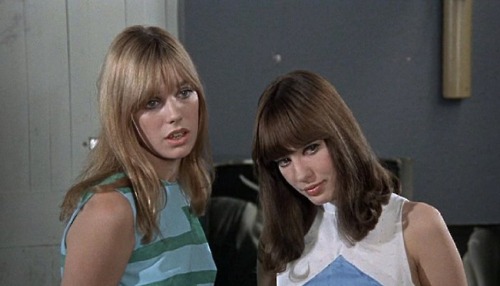
Jane Birkin, as the blond, and Gillian Hills, as the brunette, in Blow Up.
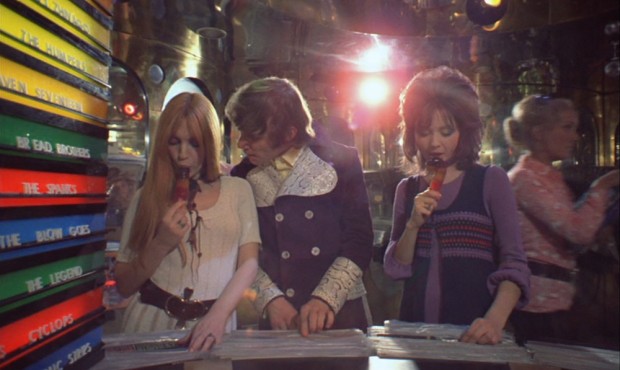
Gillian Hills, as the blond, and Barbara Scott, as the brunette, in A Clockwork Orange.
Next we see the two women reverently dressing Thomas, almost seeming as supplicants. As they do so, Thomas, who was lying down, starts up and looks at the photos beyond them. It has occurred to him there is something wrong. He realizes he hadn't saved the man after all, that he had also captured an image of his dead body beneath a tree. A mystery is what has caused Thomas to realize this when he is with these two women.
Below is the image that Thomas has realized shows the dead man behind the tree.
Thomas and the two women had sex while that image of the dead man was hanging up in the studio, Thomas not yet realizing what the image actually showed. Instead, Kubrick has the death mask portrait of Beethoven hanging above them all.
On Hills' website she states that the fast scene of the three was "Kubrick's favorite. We are like butterflies in a Perspex box." An interesting way to describe it if these are her own words rather than a comparison Kubrick made, for it takes us back to Lolita, and Nabakov, the butterfly expert, and the display of butterflies at the girl's camp where Humbert picks up Lolita after the death of her mother. The comparison to butterflies in a Perspex box, however, is odd, because butterflies in a Perspex box are dead and on display.
Hills also says Kubrick had her try out, for the casting director, dressed only in her underwear, reading the part of Marilyn Monroe in Bus Stop.
In Blow Up, Hemmings at one point sees the model Verushka though she's supposed to be in Paris. She's wearing an outfit that is printed so it looks like snake skin. What did Alex have in his bedroom? A boa constrictor. Hills states that she and McDowell played a scene with the boa that was cut.
One might wander if there is a connection had here with the two men with whom the Pierrette is found at Rainbow Fashions in Eyes Wide Shut. One has a dark curly wig on and is found within a clothing rack upon which hang feathered boas. The other pops up from behind the couch wearing a long blond wig. When Milich tears the black wig off the man inside the clothing rack he is revealed as having gray hair. When he tears the blond wig off the other man, he is revealed as having black hair. The appear to be there to engage in a threesome with an underage girl--shades of Lolita. They say they have been invited.
There is, by the way, no boa constrictor in the book, A Clockwork Orange. A snake is mentioned once but it's during the Ludovico experiment. When Alex protests he's cured, realizing they are using music he loves in the film, Dr. Brodsky tells him, "You're not cured yet. There's still a lot to be done. Only when your body reacts promptly and violently to violence, as to a snake, without further help from us, without medication, only then--"
Which is a comparison that would make no sense to Alex in the film as he was quite fond of his snake. McDowell is said to have loathed working with it, fearful, but Alex loved his pet snake and even slept with it.
We also then have a connection to the blond and brunette models at Victor's party who seem to want to entice Bill into a threesome. They state they are taking him to where the rainbow ends. So these two women are, in effect, the two Japanese men at Rainbow Fashions. I don't mean literally but by why of the morphings that Kubrick does in his recyclings of characters and events.
It would seem to me that Kubrick has perhaps brought in Hills so that this scene may reference the threesome in Blow Up, Hills switched to be blond rather than brunette. As with in Blow Up, Hills' character is silent, the brunette having the lines.
Funeral Parade of Roses
I have often enough read that A Clockwork Orange was influenced by Toshio Matsumoto's Funeral Parade of Roses, this always suggested in the scene in which Alex and his droogs are walking along the marina, comparing it with a scene in Matsumoto's film in which the transgender or transsexual character Eddie is walking along with her friends. That isn't what strikes me about that film. Instead three other things do.
Funeral Parade of Roses is an Oedipal tale in which the main character, Eddie, finds she is unable to escape fate, and that it seemingly replays over and over again. Kubrick's films all deal with fate as versus free will, and we have strong intimations of an Oedipal tale here.
As with Oedipus, Eddie gouges out her eyes at the end of the film, so she has blood running down her face, this earlier anticipated by the camera's focus on her exaggerated false eyelashes. We have this in Kubrick's film with the exaggerated eyelashes and the bloody eyeball cufflinks.
There's a scene in Funeral Parade of Roses in which Eddie's boyfriend/boss, who has a club that caters to gays, and transgender and transsexual individuals, and runs drugs out of the club's office, must clean and flee the office when detectives arrive. In a frenetic, sped-up scene, they remove the drugs while the "Infernal Galop" (the galop so named after the fastest gait of a horse) from Jacques Offenbach's "Orphée Aux Enfers" plays (Orpheus in the Underworld). The opera was a satire of Gluck's "Orfeo ed Euridice", a burlesque, and its galop became the popular "Can-Can" dance. There is another sped-up scene of a fight over which plays, "O du lieber Augustin" ("Oh, you dear Augustin"), the original lyrics being about how once everyone feasted but now there is only plague and a great corpse feast. In respect of A Clockwork Orange, the galop over the drug scene is the interesting one due to the film's treatment of cinema and drugs. The movie stands outside itself from time to time, interviewing the actors, showing the filming of certain scenes, and equates experimental film with a drug experience, in one scene an individual first saying their drug is for the eyes, like an eye drop, but then taking it orally. So when drug evidence is being removed from the office, we need to consider the correlation with film and drugs, as if film as a revolutionary tool for opening the mind is something that needs to be hidden from the system.
Though "The Village Voice" stated it could not find where the connection between A Clockwork Orange and Funeral Parade of Roses may have arisen, there's much there to connect the two films, philosophically, and concerning Oedipus and the eyes. Remember, Alex is given a drug before he watches movies, but in this case it is one that makes him nauseous when confronted with violence.
I have wondered if the use of the galop in the threesome scene may have to do with the galop used in the scene when the drugs are removed from the office.
Approx 13,800 words or 28 single-spaced pages. A 106 minute read at 130 wpm.
Go to Part 3
Go to Table of Contents of the analysis
Link to the main TOC page for all the analyses


